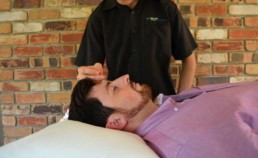Acupuncture in the Workplace
Acupuncture treatments at your workplace are intended to promote relaxation and treat pain, leaving workers feeling balanced and revitalized, so they can work optimally!
Sitting for hours on end is now understood to be a major health risk. Stress has long been known to negatively affect your health as well. Eye strain, poor ergonomics, recirculated air, and missed mealtimes are just some of the other things that can be making you unwell. If you are sick and tired of being sick and tired, there is a solution.
Benefits for the
- Reduces absenteeism
- Decreases stress levels
- Encourages greater employee focus and job retention
- Promotes a positive work environment
- Improves job productivity by strengthening mental focus and alertness
- Controls escalating health insurance costs
- Improves employee morale
- Less injuries due to repetitive strain on the body
- Promotes integrity to your employees
- Defines your company as progressive
Benefits for the
- Reduces neck and back tension/pain
- Eases eye strain
- Relieves headaches
- Improves immune function
- Reduces stress
- Enhances focus and energy
- Relief for the “mouse” hand and arm
- Relieves carpal tunnel syndrome
- Enhanced mental clarity
- Relief from headaches
- Eased digestive troubles
- Relief from allergy symptoms
- Reduced cravings for cigarettes
How does acupuncture at my workplace work?
You do not have to provide anything. We will come to your workplace with the supplies needed. We can perform acupuncture in any room of your choice.
When can acupuncture treatments be performed?
We will tailor our acupuncture visits to your schedule. We can treat you before an important meeting, during your lunch break, after a stressful project–or whenever you feel the need to relax and improve your health!
Health and Economic Benefits in the Workplace
Employees are often constrained by lack of time and/or high treatment costs and therefore do not get access to the health care treatments that they need. As a result, many corporations help solve this dilemma by providing specialized health and wellness services on-site. In turn, employers benefit from increased employee productivity, quality of output, and an overall increase in the quality of the work atmosphere. They can also reduce insurance claims filed which can result in lower premium costs. This in turn boosts employee morale who then report high job satisfaction and feel increased loyalty to the company and consequently, longevity is increased.
This is not a new idea – it has been tried, tested and found to be successful in many instances.
About 90 percent of all visits to primary care providers are related to stress, and over half of lost workdays have been shown to be stress-related. Up to 80 percent of industrial accidents in workplaces or on job sites are due to stress. Additionally, 14 percent of workers report that it was stress that caused them to change jobs or quit a job.
Employee stress, pain and illness cost companies untold amounts of lost revenues each year. However, when workers are healthy, they are less likely to take sick days or become injured on the job. They are also far more likely to be productive, focused and effective at work.
Acupuncture provides very effective treatment for stress related conditions 1 2 3
There is a strong established link between office computer work and neck and shoulder pain4 5. There have been studies specifically looking at the treatment of chronic neck and shoulder pain in sedentary workers. Acupuncture, at least twice a week over a four week period, was found to be effective treatment for the neck and shoulders, and was also found to have additional benefit of treating related headaches. The positive effects were still felt at a 3 year follow up after treatment had finished6. The effectiveness of Acupuncture in the treatment of neck and shoulder problems is backed up by numerous studies7 8 9.
It is estimated that 70–90% of people will suffer from lower back pain in some form at some point in their lives. Acupuncture is an effective treatment for lower back pain 10 11 12 13 14 15 16 17 18 19 20. In fact many studies are finding Acupuncture more effective than conventional treatment such as physiotherapy
21 22 23 24. Furthermore, it has been found to be a cost effective treatment for the treatment of lower back pain25.

